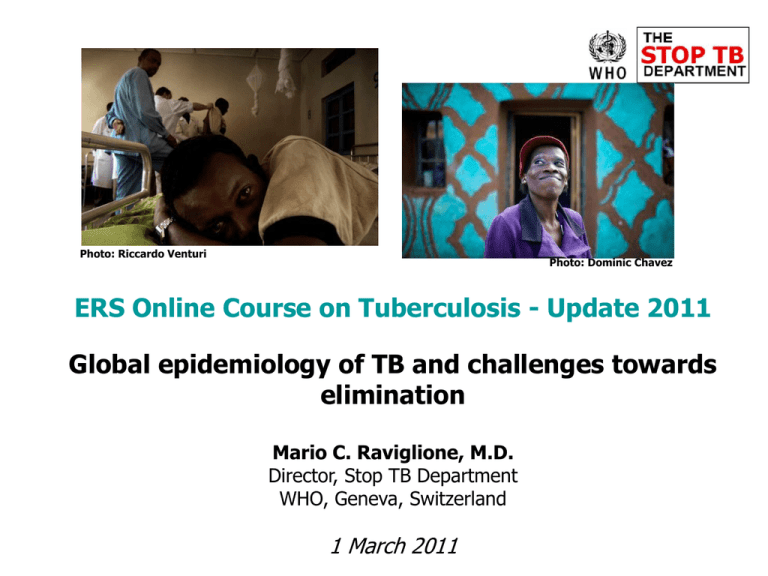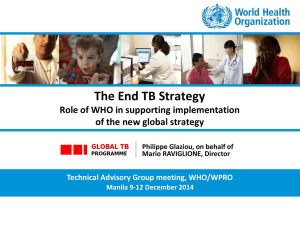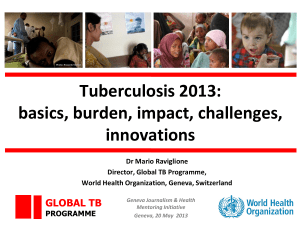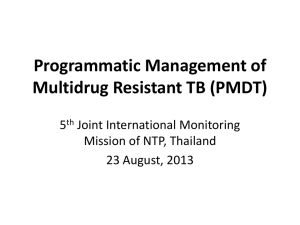
Photo: Riccardo Venturi
Photo: Dominic Chavez
ERS Online Course on Tuberculosis - Update 2011
Global epidemiology of TB and challenges towards
elimination
Mario C. Raviglione, M.D.
Director, Stop TB Department
WHO, Geneva, Switzerland
1 March 2011
Overview of this presentation
•Burden of TB, TB/HIV, MDR-TB
• Progress towards international
targets
• Challenges to be faced
• Actions in 4 broad areas
The Global Burden of TB -2009
0–24
25–49
50–99
100–299
Estimated
number of cases
Estimated
number of deaths
9.4 million
1.7 million*
300 and higher
No estimate available
All forms of TB
HIV-associated TB
Multidrug-resistant
TB (MDR-TB)
(range: 8.9–9.9 million)
1.1 million (12%)
(range: 1.0–1.2 million)
440,000
(range: 390,000–510,000)
(range: 1.5–2.0 million)
380,000
(range: 320,000–450,000)
about 150,000
*including deaths among PLHIV
TB Incidence Rates - 2009
0–24
West Pacific 20%
25–49
Americas 3%
50–99
100–299
>300
No estimate
Per 100 000 population
Africa
30%
SE Asia 35%
East Mediterranean 7%
Europe 4%
•Highest burden in Asia (55% of 9.4 million cases)
•Highest rates in Africa, due to high HIV infection rate
~80% of HIV+ TB cases in Africa
Impact of HIV on TB in Africa
•79% of all TB/HIV cases world-wide are in Africa
•50% of all TB/HIV cases world-wide in 9 African countries
•23% of the estimated 2 million HIV deaths due to TB
Notified cases per 100,000 pop. 1980-2008
% MDR-TB among new TB cases,
1994-2009
The boundaries and names shown and the designations used on this map do not imply the expression of any opinion whatsoever on the part of the World Health
Organization concerning the legal status of any country, territory, city or area or of its authorities, or concerning the delimitation of its frontiers or boundaries. Dotted lines on
maps represent approximate border lines for which there may not yet be full agreement.
WHO 2010. All rights reserved
Overview of this presentation
•Burden of TB, TB/HIV, MDR-TB
• Progress towards international
targets
• Challenges to be faced
• Actions in 4 broad areas
The global response:
Stop TB Strategy & Global Plan
1.
Pursue high-quality
DOTS expansion
2.
Address TB-HIV, MDRTB, and needs of the
poor and vulnerable
3.
Contribute to health
system strengthening
4.
Engage all care
providers
5.
Empower people with
TB and communities
6.
Enable and promote
research
To save lives, prevent suffering,
protect the vulnerable, & promote
human rights
The Global TB Control Targets
2015: Goal 6: Combat HIV/AIDS, malaria and other diseases
Target 6c: to have halted by 2015 and begun to reverse the incidence…
*Indicator 6.9: incidence, prevalence and mortality associated with TB
*Indicator 6.10: proportion of TB cases detected and cured under DOTS
2015: 50% reduction in TB prevalence and deaths by 2015
2050: elimination (<1 case per million population)
Global Plan to Stop TB 2011-2015
Launched in Johannesburg
13 October 2010
10 major targets for 2015
DOTS/lab strengthening
MDR-TB/lab strengthening
INDICATOR
TARGET
INDICATOR
TARGET
Number of countries with ≥1
smear microscopy lab per
100 000 population
149
(All countries
in plan)
36/36
Patients notified + treated
6.9 million
Number of 22 HBCs and 27
MDR-TB HBCs with >1 Cx &
DST lab to cover 0.5-1 M
population
Treatment success rate
90%
Previously treated cases tested
for MDR
100%
New cases tested for MDR
20%, all at
high-risk
MDR-TB patients treated
following WHO guidelines
100%, or
~ 270k
TB/HIV
INDICATOR
TARGET
TB patients tested for HIV
100%
HIV+ TB patients on CPT
100%
HIV+ TB patients enrolled
on ART
100%
*CPT, cotrimoxazole preventive therapy
ART, antiretroviral therapy
pp17
Achievements thus far
•
41 million patients cured, 1995-2009
•
6 million deaths averted compared to 1995
care standards
•
Mortality reduced by 35% since 1990
•
Cure rates >85%, care for TB/HIV improving
•
50% mortality targets on track globally
•
2015 MDG target on track: global TB
incidence peaked in 2004
•
But…. TB incidence declining too slowly, case
detection stagnating, and MDR-TB care only
now starting scale-up
Prevalence and mortality: global
estimates
Prevalence
Mortality
35
300
25
200
15
100
target
target
0
0
1990
2015
1990
shaded area = uncertainty band
2015
Incidence rates falling globally after
peak in 2004, but only at <1%/year
Incidence (all forms, incl. PLHIV)
Notification gap
shaded area = uncertainty band
Peak in 2004
TB Notifications
Incidence TB in PLHIV
The case detection gap: 1/3
Global notifications (black)
in the context of
estimated incidence (blue)
TB cases (millions)
9.4
6.7
5.8
3.7
shaded area = uncertainty band
Increasing notifications via PPM
(public-private mix)
NATIONAL
PARTS OF COUNTRY
Source: 2010 WHO global TB control report, Table 7, page 16
Treatment success 86% globally
Global
WHO Regions
93
W. Pacific
88
SE Asia
EMR
80
Africa
Americas
77
66
Europe
Progress in most regions, but Europe lagging behind
HIV testing for TB patients expanding
Percentage of TB patients
Although more needed to reach 100% targets in Global Plan
Africa
World
Several countries
show very high
testing rates are
achievable
Rwanda: 97%
Kenya: 88%
Tanzania: 88%
Malawi: 86%
Mozambique: 84%
CPT and ART for HIV-positive TB
patients also expanding
Percentage of HIV+ TB patients
Although more needed to reach 100% targets in Global Plan
CPT
ART
Several countries
show higher rates of
enrolment are
possible
CPT 86%–97% in 2009
Kenya, Malawi, Mozambique,
Rwanda, Tanzania, Uganda
ART close to 50% in 2009
Rwanda, Malawi
Proportion of TB patients tested for
MDR-TB remains low
New
Global plan target for 2015 =20%
Previously treated
Global plan target for 2015 =100%
MDR-TB treatment expanding
BUT only reaching ~12% of TB patients with MDR-TB
Numbers treated for MDR-TB
Global Plan target ~270,000 in 2015
Numbers treated as % total
estimated cases of MDR-TB
among all notified cases of TB
30,000
19,000
GLC = Green Light Committee
Especially low in
two regions
with largest
number of cases
Funding for TB control increasing
4.7
3.9
Overview of this presentation
•Burden of TB, TB/HIV, MDR-TB
• Progress towards international
targets
• Challenges to be faced
• Actions in 4 broad areas
What are the challenges in 2011 if
we seriously target "elimination"?
1. Funding not secure
2. Only 61% of all estimated cases reported
3. TB/HIV major impact in Africa
4. MDR-TB burden serious in former USSR and China
5. Weak health policies, systems and services
6. Non-state practitioners un-engaged
7. Communities often un-aware, un-involved, not mobilised
8. Research only starting now to produce new tools
Funding required, Global Plan
Implementation
Plan component
US$
billions,
2011–2015
IMPLEMENTATION
36.9
79%
DOTS
22.6
48%
MDR-TB
7.1
15%
TB/HIV
2.8
6%
Lab strengthening
4.0
8%
Technical assistance
0.4
1%
R&D
9.8
21%
46.7
100%
TOTAL
%
total
PLUS: Target that diagnosis should be free-of-charge or fully reimbursable by
health insurance in all 22 high-burden countries (HBCs)
Funding 2010−2011 vs. funding needs
in the Global Plan, 2011−2015
18/36 HBCs* have insufficient capacity
to diagnose MDR-TB
≥1
<1
Culture laboratories
per 5M and DST
laboratories per 10M
population, 2009
*HBC= high-burden country
Countries = Afghanistan, Armenia, Azerbaijan, Bangladesh, Belarus, Brazil, Bulgaria, Cambodia,
China, DR Congo, Estonia, Ethiopia, Georgia, India, Indonesia, Kazakhstan, Kenya, Kyrgyzstan,
Latvia, Lithuania, Mozambique, Myanmar, Nigeria, Pakistan, Philippines, Republic of Moldova,
Russian Federation,
South Africa, Tajikistan, Tanzania, Thailand, Uganda, Ukraine, Uzbekistan,
Viet Nam, Zimbabwe
High costs to patients to access TB diagnosis:
an example from Bangalore, India
28% annual
household
income per
person
50% annual
household
income per
person
Living standard definitions based on those used
in National Family Health Survey
53%
annual
household
income per
person
Pantoja A et al, IJTLD, 2009
High-level policy changes are fundamental!
World Health Assembly, May 2009…
In addition to proper basic control..
1. Remove financial barriers (UHC)
2. Ensure well trained and sufficient
human resources
3. Establish a network of labs where
rapid tests are also available
4. Ensure availability of quality drugs
5. Regulate the use of all anti-TB drugs
6. Introduce infection control
7. Establish proper surveillance
8. Promote R&D
9. Mobilize resources domestically and
internationally
Document WHA 62.15, 2009
Increasing case notifications is good,
But…it is not yet early case detection
Case recovery into the NTP by different care providers,
Bangalore, 1999-2005
•Public and private medical colleges (yellow) diagnose a huge number of cases, but many of them are from outside the city
and need to be refereed for treatment elsewhere.
•The increase in diagnosed cases represents increased notification after medical colleges and other providers started to
report to NTP in a standardised way
Limitations of today’s Diagnostics, Drugs and
Vaccine - A clear need for new tools
Diagnostics - More than 100 years old
• Detects only half of the cases in patients tested
• Ineffective for diagnosing TB in PLHIV
• Rapid tests for MDR strains available, but not yet in the field
Drugs – Last drug 40 years old
• Four drugs, taken for at least 6 months
• Not compatible with some HIV/AIDS antiretrovirals
• MDR-TB treatment lengthy, with low cure rates, expensive, toxic
Vaccine – Nearly 90 years old
• Unreliable protection against pulmonary TB
• No apparent impact on the TB epidemic
Full implementation of Global Plan: 2015 MDG
target reached but TB not eliminated by 2050
10000
Incidence/million/yr
Current rate
of decline
1000
TB incidence 10x
lower than today,
but >100x higher
than elimination
target in 2050
100
10
Elimination
target: 1 /
million / year
by 2050
Elimination 16%/yr
Global Plan 6%/yr
Current trajectory 1%/yr
1
2000
2010
2020
2030
Year
2040
2050
Overview of this presentation
•Burden of TB, TB/HIV, MDR-TB
• Progress towards international
targets
• Challenges to be faced
• Actions in 4 broad areas
Innovative action needed in 4 spheres
"Moving beyond the TB box"
TB care and
control
•Early & increased case detection
•Scale-up TB/HIV and MDR-TB
interventions
•M&E and impact measurement
•Engage all care providers
•Active screening among at-risk
populations
•Introduction of modern technology
Health systems
and policies
Development
agenda
•Close NTP funding gaps
•Provide free services,
ensure quality drugs,
regulate private care,
better M&E, collaboration
on co-morbidities
Research sensu lato
•Socio-economic factors:
living conditions, food
insecurity, awareness, risk
behaviour, access to care
•Reduce costs to patients to
minimise impoverishment
•Secure political
commitment and civil society
awareness
•Target new tools
•Operational research and transfer of
technology
Add. Effects = effects also on latency
and infectiousness of cases in vaccinated
•Led & NAAT at microscopy lab level
•Dipstick at point of care
Source: L. Abu Raddad et al, PNAS 2009
Potential impact of new TB vaccines,
diagnostics and drugs in SE Asia
•Regimen 1 = 4-month, no effect on DR
•Regimen 2 = 2-month, 90% effective in M/XDR
•Regimen 3 = 10-day, 90% effective in M/XDR
Elimination of TB by 2050 requires
synergistic interventions
NOT by preventing
infection & treating active
TB
(both act on cutting
transmission)
Dye C & Williams BG, J.R. Soc. Interface 2007
But by treating latent infection and active TB or
by preventing and treating latent infection (cutting transmission and reactivation)
Population attributable fraction –
Selected Risk Factors & Determinants
Relative risk for
active TB disease
Weighted
prevalence
(22 HBCs)
Population
Attributable
Fraction in Adults
HIV infection
20.6/26.7*
1.1%
Malnutrition
3.2**
16.5%
Diabetes
3.1
3.4%
19%
27%
6%
Alcohol use
(>40g / d)
2.9
7.9%
13%
Active
smoking
2.6
18.2%
23%
Indoor Air
Pollution
1.5
71.1%
26%
Sources: Lönnroth K, Raviglione M. Global Epidemiology of Tuberculosis: Prospects for Control. Semin Respir Crit Care Med
2008; 29: 481-491. *Updated data in GTR 2009. RR=26.7 used for countries with HIV <1%. **Updated data from Lönnroth et
al. A consistent log-linear relationship between tuberculosis incidence and body-mass index.
Conclusions
1. The world is on track to achieve the 2015 targets
for reductions in incidence (fairly un-ambitious
target) and mortality (35% decline since 1990)
2. Achieving universal access to TB diagnosis and
care requires substantial strengthening of
laboratory services, further progress in
implementation of PPM and TB/HIV interventions,
massive scale-up of treatment for MDR-TB, and
reduction of financial barriers faced by TB patients
3. Work in additional areas of action (R&D and
advocacy to remove determinants) is necessary to
seriously think of elimination one day
Many thanks
to all
Acknowledgements: Stop TB Dept. at WHO; WHO's Regional Offices;
400 NTP Officers from all over the world.
USAID for financing most of our work, The Government of Japan






